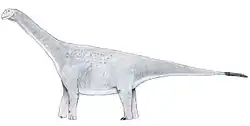| Arrudatitan Temporal range: Late Cretaceous, | |
|---|---|
.jpg.webp) | |
| Left femur of A. maximus, from the holotype specimen MPMA 12-0001-97 | |
| Scientific classification | |
| Domain: | Eukaryota |
| Kingdom: | Animalia |
| Phylum: | Chordata |
| Clade: | Dinosauria |
| Clade: | Saurischia |
| Clade: | †Sauropodomorpha |
| Clade: | †Sauropoda |
| Clade: | †Macronaria |
| Clade: | †Titanosauria |
| Clade: | †Lithostrotia |
| Clade: | †Aeolosaurini |
| Genus: | †Arrudatitan Silva et al., 2021 |
| Type species | |
| †Arrudatitan maximus Santucci & De Arruda-Campos, 2011 | |
Arrudatitan (meaning "Arruda's giant") is an extinct genus of titanosaur sauropod dinosaur known from the Late Cretaceous (Campanian-Maastrichtian)-aged Adamantina Formation of Brazil. The type species, A. maximus, was named and described in 2011 as a species of Aeolosaurus,[1] but was separated into its own genus in 2021.[2] It was relatively gracile for a titanosaur.
Discovery and naming
_1.jpg.webp)
The holotype, MPMA 12-0001-97, which includes two partial posterior cervicals, fragments of several dorsals, parts of nine caudals, seven partial cervical ribs, twelve partial dorsal ribs, eight chevrons, a fragmentary scapula and arm bones, the left and partial right femur, the left ischium, and fragments; with other specimens known, such as the isolated middle caudal vertebra MPP 248,[1] was discovered in 1997 by Ademir Frare and his 12-year-old nephew Luiz Augusto dos Santos Frare in a field in Cândido Rodrigues. They notified palaeontologist Antônio Celso de Arruda Campos and the holotype was collected between 1997 and 1998 by staff of the Museu de Paleontologia de Monte Alto and it was first mentioned in scientific literature by Santucci and Bertini (2001).[3] They noted that crocodylomorph and theropod teeth were found near the holotype, but no bite marks were present.[3] In 2009, Fernando Novas briefly noted on the holotype, noting its size.[4]
MPMA 12-0001-97 was initially assigned to Aeolosaurus in 2011, when the species Aeolosaurus maximus was created by Santucci & De Arruda-Campos.[1] As early as Martinelli et al. (2011), published shortly before Aeolosaurus maximus was described, the caudal vertebra of the holotype of Aeolosaurus maximus was seen as an indeterminate aeolosaurin distinct from Aeolosaurus,[5] with Bandeira et al. (2016)[6] referring to the species as "A". maximus throughout their paper describing the titanosaurian sauropod Austroposeidon magnificus due to Aeolosaurus maximus being sufficiently different from Aeolosaurus but had not yet been placed within a different genus; and subsequent analyses, such as Silva et al. (2019)[7] and Hechenleitner et al. (2020),[8] found that Aeolosaurus maximus did not belong in the Aeolosaurus genus and so the new genus Arrudatitan was erected in 2021 by Silva et al..[2]
Description
Arrudatitan grew up to 15 metres (49 ft) when fully grown, based on the size of the holotype.[1][4] The femur length of Arrudatitan is 1.55 metres (5.1 ft).
Classification
The species Aeolosaurus maximus was named by Santucci and De Arruda-Campos in 2011 for titanosaur remains recovered in the Adamantina Formation of Brazil. However, subsequent cladistic analyses, such as those by Silva et al. in 2019[7] and Hechenleitner et al. in 2020[8] have considered A. maximus to be outside Aeolosaurus, the former analysis finding it to be sister to Rinconsauria and the latter finding it to be closely related to a clade consisting of Punatitan and the other two Aeolosaurus species. In light of this, Silva et al. transferred it to the new genus Arrudatitan, after Brazilian paleontologist Antonio Celso de Arruda Campos.
A cladogram of the phylogenetic analysis performed by Silva et al., 2021 is shown below:[2]
| Rinconsauria |
| |||||||||||||||||||||||||||||||||||||||||||||||||||||||||
References
- 1 2 3 4 Santucci, R.M.; De Arruda-Campos, A.C. (2011). "A new sauropod (Macronaria, Titanosauria) from the Adamantina Formation, Bauru Group, Upper Cretaceous of Brazil and the phylogenetic relationships of Aeolosaurini". Zootaxa. 3085 (1): 1. doi:10.11646/zootaxa.3085.1.1. ISSN 1175-5334.
- 1 2 3 Silva, J.C. Jr.; Martinelli, A.G.; Iori, F.V.; Marinho, T.S.; Hechenleitner, E.M.; Langer, M.C. (2021). "Reassessment of Aeolosaurus maximus, a titanosaur dinosaur from the Late Cretaceous of Southeastern Brazil". Historical Biology: An International Journal of Paleobiology. 34 (3): 403–411. doi:10.1080/08912963.2021.1920016. S2CID 235526860.
- 1 2 SANTUCCI, RODRIGO MILONI; BERTINI, REINALDO JOSÉ (2001-09-01). "DISTRIBUIÇÃO PALEOGEOGRÁFICA E BIOCRONOLÓGICA DOS TITANOSSAUROS (SAURISCHIA, SAUROPODA) DO GRUPO BAURU, CRETÁCEO SUPERIOR DO SUDESTE BRASILEIRO". Revista Brasileira de Geociências. 31 (3): 307–314. doi:10.25249/0375-7536.2001313307314. ISSN 0375-7536.
- 1 2 Novas, F. E. (2009). The Age of Dinosaurs in South America. Indiana University Press, Bloomington and Indianapolis, Indiana.
- ↑ Martinelli, Agustín; Riff, Douglas; Lopes, Renato (2011-09-14). "Discussion about the occurrence of the genus Aeolosaurus Powell 1987 (Dinosauria, Titanosauria) in the Upper Cretaceous of Brazil". Gaea: Journal of Geoscience. 7 (1): 34–40. Bibcode:2011Gaea....7...34M. doi:10.4013/gaea.2011.71.03. ISSN 1983-3628.
- ↑ Bandeira, K.L.N.; Medeiros Simbras, F.; Batista Machado, E.; de Almeida Campos, D.; Oliveira, G.R.; Kellner, A.W.A. (2016). "A New Giant Titanosauria (Dinosauria: Sauropoda) from the Late Cretaceous Bauru Group, Brazil". PLOS ONE. 11 (10): e0163373. Bibcode:2016PLoSO..1163373B. doi:10.1371/journal.pone.0163373. PMC 5051738. PMID 27706250.
- 1 2 Silva, J.C.G. Jr.; Marinho, T.S.; Martinelli, A.G.; Langer, M.C. (2019). "Osteology and systematics of Uberabatitan ribeiroi (Dinosauria; Sauropoda): a Late Cretaceous titanosaur from Minas Gerais, Brazil". Zootaxa. 4577 (3): 401–438. doi:10.11646/zootaxa.4577.3.1. PMID 31715707. S2CID 145939866.
- 1 2 E. Martín Hechenleitner; Léa Leuzinger; Agustín G. Martinelli; Sebastián Rocher; Lucas E. Fiorelli; Jeremías R. A. Taborda; Leonardo Salgado (2020). "Two Late Cretaceous sauropods reveal titanosaurian dispersal across South America". Communications Biology. 3 (1): Article number 622. doi:10.1038/s42003-020-01338-w. PMC 7591563. PMID 33110212.











